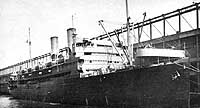
The U.S. Army Transport Siboney (of 6937 gross tons) was built at Philadelphia, Pennsylvania, in 1918 as the commercial passenger liner of the same name. During 1918 and 1919 she served as USS Siboney (ID # 2999), then returned to civilian employment as the New York and Cuba Mail Steamship Company's S.S. Siboney. With World War II raging in Europe and the United States striving to enhance its defenses, in June 1941 the ship was chartered by the Army. As USAT Siboney, she spent the rest of the year carrying military passengers between the United States, Newfoundland, Bermuda, Panama and the Caribbean. Beginning in December 1941 the transport made a long voyage to Iraq, via Capetown, returning to the U.S. in April 1942. Siboney was thereafter engaged in taking troops to the British Isles, as well as making trips to North Africa, Gibraltar, South Africa, South America and the West Indies.
Siboney was undergoing a major refit at New York when, in January 1944, she was selected for conversion to a U.S. Army Hospital Ship. Renamed Charles A. Stafford, she emerged from the shipyard in September with a single smokestack replacing her original two, new boilers and a number of other improvements. Between October 1944 and May 1945 she made several trips between Charleston, South Carolina, and the United Kingdom, and one voyage to the Mediterranean. The hospital ship was then modified for operation in the southwestern Pacific. Departing the East Coast in August 1945, she steamed to the Philippines by way of the Panama Canal and Hawaii. In February 1946 Charles A. Stafford returned to the Atlantic for further service between the U.S. and Britain. In February 1948 she was laid up in U.S. Maritime Administration's James River Reserve Fleet, under the name Siboney. She was sold for scrapping in January 1957.
This page features all the views we have concerning the U.S. Army Transport Siboney and the Army Hospital Ship Charles A. Stafford.
For additional views related to this ship, taken prior to
her U.S. Army service, see:
| If you want higher resolution reproductions than the digital images presented here, see: "How to Obtain Photographic Reproductions." |
Click on the small photograph to prompt a larger view of the same image.
For additional views related to this ship, taken prior to
her U.S. Army service, see:
| If you want higher resolution reproductions than the digital images presented here, see: "How to Obtain Photographic Reproductions." |
Page made 28 November 2005